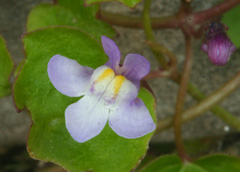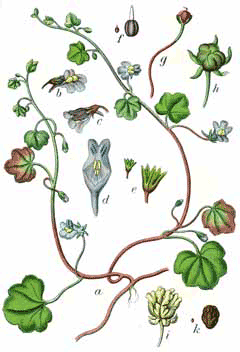 |
|
|
 |
| http://upload.wikimedia.org/wikipedia/commons/6/6d/Cymbalaria_muralis_Sturm21.jpg |
Translate this page:
Summary
Physical Characteristics

 cymbalaria muralis is a PERENNIAL growing to 0.1 m (0ft 4in) by 0.4 m (1ft 4in).
cymbalaria muralis is a PERENNIAL growing to 0.1 m (0ft 4in) by 0.4 m (1ft 4in).
See above for USDA hardiness. It is hardy to UK zone 3 and is not frost tender. It is in flower from May to September, and the seeds ripen from July to October. The species is hermaphrodite (has both male and female organs) and is pollinated by Bees. The plant is self-fertile.
Suitable for: light (sandy), medium (loamy) and heavy (clay) soils and prefers well-drained soil. Suitable pH: mildly acid, neutral and basic (mildly alkaline) soils. It can grow in semi-shade (light woodland). It prefers dry or moist soil.
UK Hardiness Map
US Hardiness Map
Synonyms
Linaria cymbalaria.
Habitats
Woodland Garden Dappled Shade; Shady Edge; North Wall. In. East Wall. In. South Wall. In. West Wall. In.
Edible Uses
Edible Parts: Leaves
Edible Uses:
Leaves - raw[4, 115, 177]. The leaves have been used in salads, being acrid and pungent like cress[4]. We find them rather bitter and not very pleasant, though they are available all year round and so might be useful in the winter[K]. Some caution is advised, see the notes above on toxicity.
References More on Edible Uses
Medicinal Uses
Plants For A Future can not take any responsibility for any adverse effects from the use of plants. Always seek advice from a professional before using a plant medicinally.
Antiscorbutic Vulnerary
The herb is antiscorbutic and vulnerary[4, 7]. It is used externally as a poultice on fresh wounds to stop the bleeding[7]. There are reports that it has been used with success in India for the treatment of diabetes[4, 240].
References More on Medicinal Uses
Now available: PLANTS FOR YOUR FOOD FOREST: 500 Plants for Temperate Food Forests and Permaculture Gardens.
An important new book from PFAF. It focuses on the attributes of plants suitable for food forests, what each can contribute to a food forest ecosystem, including carbon sequestration, and the kinds of foods they yield. The book suggests that community and small-scale food forests can provide a real alternative to intensive industrialised agriculture, and help to combat the many inter-related environmental crises that threaten the very future of life on Earth.
Read More
Other Uses
Dye
A clear yellow dye is obtained from the flowers, though it is not very permanent[4, 115].
Special Uses
References More on Other Uses
Cultivation details
Prefers a moderately good soil and some shade[1]. Plants usually self-sow freely[188] and can be invasive, especially when grown on old walls[200]. They succeed both on dry-stone walls and on old mortared walls[219].
References Carbon Farming Information and Carbon Sequestration Information
Temperature Converter
Type a value in the Celsius field to convert the value to Fahrenheit:
Fahrenheit:
The PFAF Bookshop
Plants For A Future have a number of books available in paperback and digital form. Book titles include Edible Plants, Edible Perennials, Edible Trees, and Woodland Gardening. Our new book to be released soon is Edible Shrubs.
Shop Now
Propagation
Seed - surface sow March to June in a cold frame and do not exclude light. The seed usually germinates in 2 - 4 weeks at 18°c[164]. When they are large enough to handle, prick the seedlings out into individual pots and plant them out into their permanent positions in the summer. Division in late spring. Very easy, larger clumps can be replanted direct into their permanent positions, though it is best to pot up smaller clumps and grow them on in a cold frame until they are rooting well. Plant them out in the spring.
Other Names
If available other names are mentioned here
Native Plant Search
Search over 900 plants ideal for food forests and permaculture gardens. Filter to search native plants to your area. The plants selected are the plants in our book 'Plants For Your Food Forest: 500 Plants for Temperate Food Forests and Permaculture Gardens, as well as plants chosen for our forthcoming related books for Tropical/Hot Wet Climates and Mediterranean/Hot Dry Climates. Native Plant Search
Found In
Countries where the plant has been found are listed here if the information is available
Weed Potential
Right plant wrong place. We are currently updating this section.
Please note that a plant may be invasive in one area but may not in your area so it’s worth checking.
Conservation Status
IUCN Red List of Threatened Plants Status :

Growth: S = slow M = medium F = fast. Soil: L = light (sandy) M = medium H = heavy (clay). pH: A = acid N = neutral B = basic (alkaline). Shade: F = full shade S = semi-shade N = no shade. Moisture: D = dry M = Moist We = wet Wa = water.

Expert comment
Author
P.Gaertn.B.Mey.&Scherb.
Botanical References
17200
Links / References
For a list of references used on this page please go here
Readers comment
| Add a comment |
|
If you have important information about this plant that may help other users please add a comment or link below. Only comments or links that are felt to be directly relevant to a plant will be included. If you think a comment/link or information contained on this page is inaccurate or misleading we would welcome your feedback at [email protected]. If you have questions about a plant please use the Forum on this website as we do not have the resources to answer questions ourselves.
* Please note: the comments by website users are not necessarily those held by PFAF and may give misleading or inaccurate information.
To leave a comment please Register or login here All comments need to be approved so will not appear immediately.
|
Subject : cymbalaria muralis
|
|
|
|